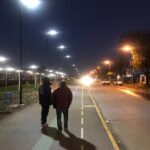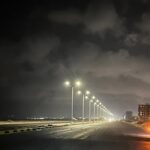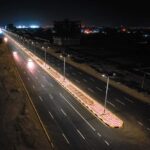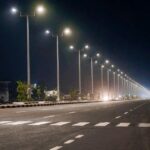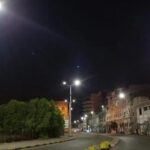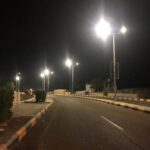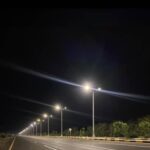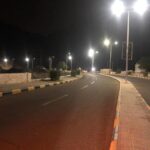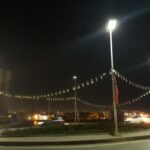In an era marked by a pressing need for sustainable solutions, the concept of retrofitting conventional street lights with solar technology has emerged as a beacon of innovation. Solar street light retrofit kits represent a transformative approach to modernizing urban lighting infrastructure. Let’s dive into the intricacies of solar street light retrofit kits, unraveling their functionality, benefits, and the role they play in shaping sustainable communities of tomorrow. Additionally, we’ll uncover essential strategies to enhance the lifespan of these kits.
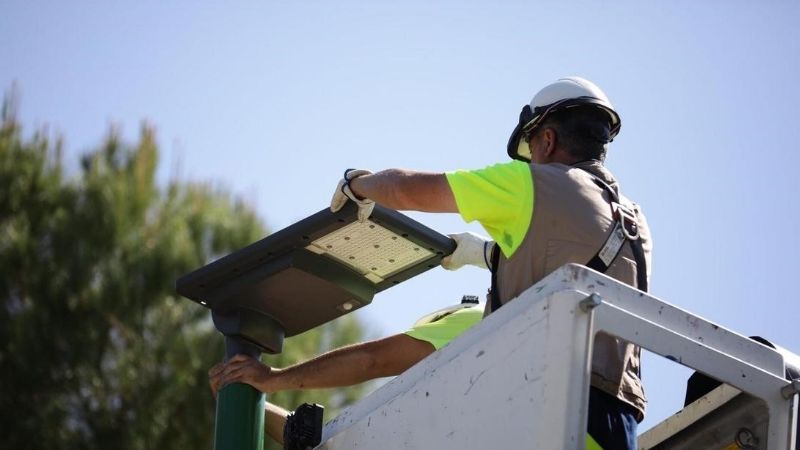
Solar street light retrofit kits installation
Components of solar street light retrofit kits
Solar street light retrofit kits typically consist of several key components, each playing a crucial role in the functionality and performance of the system. These include:
- Solar Panels: These panels are the primary component responsible for capturing sunlight and converting it into electricity through photovoltaic (PV) cells. The size and efficiency of the solar panels determine the amount of energy generated.
- LED Luminaires: Energy-efficient Light Emitting Diode (LED) luminaires serve as the light source in solar street light retrofit kits. LEDs offer high brightness levels while consuming minimal energy, making them ideal for solar-powered applications.
- Battery Storage System: A battery storage system is essential for storing the electricity generated by the solar panels during the day for use during the night or periods of low sunlight. Typically, these systems utilize rechargeable batteries such as lithium-ion or lead-acid batteries.
- Charge Controller: The charge controller regulates the flow of electricity from the solar panels to the battery storage system, preventing overcharging or deep discharging of the batteries. It also ensures efficient charging and prolongs the lifespan of the batteries.
- Photocell or Motion Sensor: Photocells or motion sensors are often incorporated into solar street light retrofit kits to enable automatic operation. Photocells detect ambient light levels and switch the lights on at dusk and off at dawn, while motion sensors activate the lights in response to detected movement, conserving energy when illumination is not required.
- Mounting Hardware: Mounting hardware such as poles, brackets, and fixtures are included to support the installation of the solar panels, LED luminaires, and other components securely onto existing street light infrastructure.
- Wiring and Connectors: Wiring and connectors are essential for interconnecting the various components of the solar street light system, ensuring proper electrical connectivity and functionality.
Components of solar street light retrofit kits
Solar street light retrofit kits maintenance tips
What should you do to increase the lifespan of your kits? Let’s discover.
Cleaning and dirt removal
One often overlooked aspect of maintenance is cleaning and dirt removal. Over time, dirt, dust, and other debris can accumulate on the solar panels, reducing their ability to absorb sunlight efficiently. This buildup can significantly impact the performance of the solar street lights, diminishing their output and ultimately affecting their effectiveness in illuminating the area they are installed in.
Regular cleaning is essential to keep solar panels operating at peak performance. Ideally, cleaning should be done at least once every few months, or more frequently in dusty or heavily polluted environments. The process is relatively straightforward and typically involves using a soft brush or cloth along with a mild detergent and water to gently scrub the surface of the solar panels. It’s important to avoid using abrasive materials or harsh chemicals that could scratch or damage the panels.
In addition to cleaning the solar panels themselves, it’s also essential to inspect and clean other components of the retrofit kit, such as the light fixtures and battery housing. Dirt and debris can accumulate in these areas as well, potentially interfering with the proper functioning of the street lights. Regular inspections can help identify any buildup or damage early on, allowing for timely maintenance and repairs.
Battery maintenance
Proper battery maintenance begins with regular inspections to check for signs of corrosion, leaks, or physical damage. Any such issues should be addressed promptly to prevent further deterioration and ensure the safety of the system. Cleaning the battery terminals and connections periodically helps prevent corrosion buildup, which can impede the flow of electricity and reduce efficiency. Monitoring the battery’s state of charge is essential for preventing overcharging or deep discharging, both of which can significantly shorten its lifespan. Implementing a suitable charge controller within the system can regulate the charging process, preventing excessive voltage or current from damaging the battery.
Storage of the batteries during periods of inactivity is also crucial for maintaining their health and performance. When not in use, batteries should be stored in a cool, dry environment away from direct sunlight and extreme temperatures. Before storage, it’s advisable to fully charge the batteries and disconnect them from the system to prevent self-discharge and potential damage from parasitic loads.
Regular performance testing and capacity checks help assess the health of solar street light batteries and identify any potential issues before they escalate. This may involve conducting discharge tests to measure the battery’s capacity under load and voltage readings to gauge its overall health. Any significant deviations from expected performance metrics should prompt further investigation or replacement of the battery as needed.
Checking wiring and connections
One primary reason to regularly inspect the wiring and connections is to prevent potential safety hazards. Over time, exposure to weather elements, temperature fluctuations, and general wear and tear can degrade the integrity of the wiring. Frayed or damaged wires can lead to electrical shorts, sparking, or even fires, posing risks not only to the lighting system itself but also to nearby structures and individuals.
Checking the connections helps to maintain the efficiency of the solar street light system. Loose or corroded connections can impede the flow of electricity, resulting in reduced power output or intermittent operation. By ensuring that all connections are secure and free of corrosion, the system can consistently harness solar energy to illuminate the streets effectively.
Additionally, proper maintenance of wiring and connections contributes to the overall reliability of the solar street light retrofit kits. Consistently functioning lighting systems enhance safety and visibility on roads and pathways, promoting a sense of security for pedestrians and motorists alike. By upholding the integrity of the electrical components, municipalities and organizations can ensure that their solar street lighting infrastructure remains dependable and resilient over time.
Solar Street Light connection test
Testing light operation
Testing light operation helps you detect malfunction or degradation. LED lights can experience issues such as dimming, flickering, or complete failure over time due to various factors like environmental conditions or manufacturing defects. By conducting routine tests, you can identify these problems promptly and take corrective actions to prevent further deterioration or potential safety hazards. Moreover, testing the light operation allows for performance monitoring and benchmarking. By measuring parameters like luminous flux, color temperature, and power consumption, you can assess the overall health of the LED lights within the solar street light retrofit kits. This data helps in evaluating the effectiveness of the retrofitting solution.
Additionally, regular testing contributes to the longevity of the entire street lighting system. LED lights are known for their durability and energy efficiency, but like any other electronic component, they require monitoring and occasional adjustments to maintain optimal performance. By identifying and addressing issues early on, maintenance efforts can extend the lifespan of the LED lights, reducing the frequency of replacements and overall operational costs.
Monitoring energy output
By continuously tracking the amount of energy generated by the solar panels and consumed by the street lights, you can identify fluctuations or deviations from expected levels. Moreover, monitoring energy output provides valuable data for performance analysis and optimization efforts. By analyzing trends in energy production and consumption over time, you can identify patterns and opportunities for improvement. This data-driven approach enables informed decision-making regarding maintenance schedules, equipment upgrades, and energy management strategies, ultimately maximizing the return on investment in solar street light retrofit kits.
In addition to operational benefits, monitoring energy output can also support regulatory compliance and reporting requirements. Many jurisdictions have regulations or incentives related to energy efficiency and renewable energy adoption. By documenting the performance of solar street light retrofit kits through comprehensive energy monitoring, you can ensure compliance with applicable standards and leverage opportunities for incentives or rebates.
Weatherproofing
Using durable materials for the construction of solar street light retrofit kits is very important. This includes corrosion-resistant metals for the fixture housing and high-quality seals and gaskets to prevent water ingress. By choosing materials that can withstand exposure to moisture, UV radiation, and temperature fluctuations, the vulnerability of the retrofit kits to environmental damage is significantly reduced.
Proper installation techniques contribute to the overall weatherproofing of solar street light retrofit kits. Ensuring secure mounting of the fixtures and proper positioning of the solar panels minimizes the risk of damage from strong winds or heavy precipitation. Sealing all electrical connections and junction boxes effectively protects them from moisture infiltration, preventing potential short circuits or electrical failures.
In regions prone to extreme weather conditions, additional weatherproofing measures may be necessary to enhance the resilience of solar street light retrofit kits. This could involve installing protective enclosures or shields to shield the components from direct exposure to harsh elements. Implementing proactive measures such as applying weather-resistant coatings or treatments can further enhance the durability of the retrofit kits, mitigating the effects of prolonged exposure to outdoor conditions.
Professional maintenance
Professional maintenance also involves testing and recalibration. Technicians should periodically test the performance of the solar panels, batteries, and other electronic components to ensure they are operating within optimal parameters. Any deviations or inconsistencies should be addressed promptly to prevent performance issues or system failures. Recalibration may also be necessary to adjust the solar street light retrofit kits’ settings.
It also includes proactive measures to mitigate potential risks. This may involve reinforcing mounting structures, securing wiring connections, and implementing measures to protect against vandalism or theft. By addressing vulnerabilities and ensuring the robustness of the installation, maintenance professionals help safeguard the longevity and reliability of the solar street light retrofit kits.
solar street light mounting structure checkup
Conclusion
If you’re armed with these 7 crucial tips for maintaining your solar street light retrofit kit, you’re not just equipped with knowledge – you’re empowered to ensure your kit’s longevity and efficiency. Do you have any questions? Contact us.





